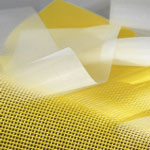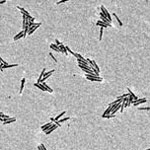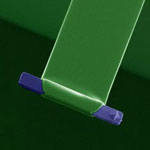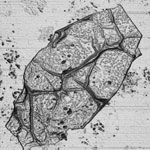Showing Spotlights 1745 - 1752 of 2853 in category All (newest first):
 A few years ago, researchers determined that the stiffness of cancer cells affects the way they spread. When cancer is becoming metastatic, or invading other organs, the diseased cells must travel throughout the body. Because the cells need to enter the bloodstream and maneuver through tight anatomical spaces, cancer cells are much more flexible, or softer, than normal cells. With this knowledge, researchers wanted to understand the cell mechanics associated with the anticancer treatment of cells from patient samples; in particular they were interested in reporting the effects of green tea extract due to the fact that is was a natural product, it has know anti-cancer effects and it is widely consumed in beverage form around the world.
A few years ago, researchers determined that the stiffness of cancer cells affects the way they spread. When cancer is becoming metastatic, or invading other organs, the diseased cells must travel throughout the body. Because the cells need to enter the bloodstream and maneuver through tight anatomical spaces, cancer cells are much more flexible, or softer, than normal cells. With this knowledge, researchers wanted to understand the cell mechanics associated with the anticancer treatment of cells from patient samples; in particular they were interested in reporting the effects of green tea extract due to the fact that is was a natural product, it has know anti-cancer effects and it is widely consumed in beverage form around the world.
Apr 5th, 2011
 In order to find replacement materials for ITO, scientists have been working with carbon nanotubes, graphene, and other nanoscale materials such as nanowires. While many of these approaches work fine in the lab, upscaleability usually has been an issue. Researchers at Empa, the Swiss Federal Laboratories for Material Science and Technology, have now demonstrated another solution: they presented a transparent and flexible electrode based on a precision fabric with metal and polymer fibers woven into a mesh. The team demonstrated organic solar cells fabricated on their flexible precision fabrics as well as on conventional glass/ITO substrates and found very similar performance characteristics.
In order to find replacement materials for ITO, scientists have been working with carbon nanotubes, graphene, and other nanoscale materials such as nanowires. While many of these approaches work fine in the lab, upscaleability usually has been an issue. Researchers at Empa, the Swiss Federal Laboratories for Material Science and Technology, have now demonstrated another solution: they presented a transparent and flexible electrode based on a precision fabric with metal and polymer fibers woven into a mesh. The team demonstrated organic solar cells fabricated on their flexible precision fabrics as well as on conventional glass/ITO substrates and found very similar performance characteristics.
Apr 4th, 2011
 It started innocently enough with isolated instances of smoke coming out of computers. Then networks crashed. Now, programs are malfunctioning on a large scale, shutting down the Vatican's huge computer infrastructure which it depends on to manage its billions upon billions of investment dollars, real estate portfolios, and art collections. It is difficult to obtain all the details, but it appears that some form of nanotechnology got out of control. Surprisingly, and against its deeply ingrained reflexes of total openness and transparency, the Vatican initially tried to cover the whole thing up. Until a tabloid reporter got wind of what had happened and the whole thing became public with an article today (April 1) in an Italian tabloid that had this sensation-seeking headline splashed all over the front page: "Gay nanobots ballano Bunga-Bunga in Vaticano" - Gay nanobots dance Bunga-Bunga in the Vatican.
It started innocently enough with isolated instances of smoke coming out of computers. Then networks crashed. Now, programs are malfunctioning on a large scale, shutting down the Vatican's huge computer infrastructure which it depends on to manage its billions upon billions of investment dollars, real estate portfolios, and art collections. It is difficult to obtain all the details, but it appears that some form of nanotechnology got out of control. Surprisingly, and against its deeply ingrained reflexes of total openness and transparency, the Vatican initially tried to cover the whole thing up. Until a tabloid reporter got wind of what had happened and the whole thing became public with an article today (April 1) in an Italian tabloid that had this sensation-seeking headline splashed all over the front page: "Gay nanobots ballano Bunga-Bunga in Vaticano" - Gay nanobots dance Bunga-Bunga in the Vatican.
Apr 1st, 2011
 Brain-computer interfaces, neural probes, brain implants - they all require intensive in vivo studies on how to best combine inorganic electronics with organic neurons. Currently, most neural culture studies suffer from the fact that their cells migrate on a flat surface and are directly exposed to the culture solution, which do not reflect the microenvironment in vivo - neurons, though, can alter their behaviors dramatically in response to the environment change. Ideal cultures, therefore, should mimic the native neural microenvironment to capture the normal cell behavior. This has motivated a group of researchers to come up with this a semiconductor nanomembrane tube approach, which provides a 3D confinement that can potentially isolate the cells from the culture solution. Since these tubes are made from a semiconductor material, it means that they can be integrated with electronic functionalities such as voltage sensors.
Brain-computer interfaces, neural probes, brain implants - they all require intensive in vivo studies on how to best combine inorganic electronics with organic neurons. Currently, most neural culture studies suffer from the fact that their cells migrate on a flat surface and are directly exposed to the culture solution, which do not reflect the microenvironment in vivo - neurons, though, can alter their behaviors dramatically in response to the environment change. Ideal cultures, therefore, should mimic the native neural microenvironment to capture the normal cell behavior. This has motivated a group of researchers to come up with this a semiconductor nanomembrane tube approach, which provides a 3D confinement that can potentially isolate the cells from the culture solution. Since these tubes are made from a semiconductor material, it means that they can be integrated with electronic functionalities such as voltage sensors.
Mar 31st, 2011
 Regenerative medicine, in particular the area of tissue regeneration, is seeing a rapidly growing field of novel biomaterials that can act as bioactive scaffolds that induce tissue regeneration; that is in contrast to the more traditional concept of passively accepted implant materials. In order to present biological stimuli to the physiological environment and trigger tissue repair, optimal integration of synthetic biomaterials within the surrounding tissue is of paramount importance. In that respect, hydrogels made from biodegradable polymers are ideal candidates since they are generally biocompatible, biodegradable, and, in some cases, injectable. New research has provided firm evidence for a feasible bottom-up approach for the preparation of injectable gels by employing oppositely charged gelatin nanospheres as building blocks.
Regenerative medicine, in particular the area of tissue regeneration, is seeing a rapidly growing field of novel biomaterials that can act as bioactive scaffolds that induce tissue regeneration; that is in contrast to the more traditional concept of passively accepted implant materials. In order to present biological stimuli to the physiological environment and trigger tissue repair, optimal integration of synthetic biomaterials within the surrounding tissue is of paramount importance. In that respect, hydrogels made from biodegradable polymers are ideal candidates since they are generally biocompatible, biodegradable, and, in some cases, injectable. New research has provided firm evidence for a feasible bottom-up approach for the preparation of injectable gels by employing oppositely charged gelatin nanospheres as building blocks.
Mar 30th, 2011
 The power conversion efficiency of solar cells made of conjugated polymer/nanorod nanocomposites can be maximized when the nanocomposites are aligned perpendicularly between two electrodes for effective exciton dissociation and transport. To realize this, external fields can be applied to induce the self-assembly/alignment. The challenge is how to assemble them over a large scale - current self-assembly studies of cadmium selenide nanorods in literature are limited to only a micrometer scale. New design approaches are therefore needed to solve this problem. Due to their intrinsic structural anisotropy, nanorods possess many unique properties that make them potentially better nanocrystals than quantum dots for photovoltaics and biomedical applications.
The power conversion efficiency of solar cells made of conjugated polymer/nanorod nanocomposites can be maximized when the nanocomposites are aligned perpendicularly between two electrodes for effective exciton dissociation and transport. To realize this, external fields can be applied to induce the self-assembly/alignment. The challenge is how to assemble them over a large scale - current self-assembly studies of cadmium selenide nanorods in literature are limited to only a micrometer scale. New design approaches are therefore needed to solve this problem. Due to their intrinsic structural anisotropy, nanorods possess many unique properties that make them potentially better nanocrystals than quantum dots for photovoltaics and biomedical applications.
Mar 29th, 2011
 The complex processes inside living systems emerge from the interactions of countless molecules. Understanding these interactions at the single molecule level is of great importance because mechanisms governing their function can be revealed best by interrogating individual molecules. Scientists rely on single-molecule techniques that allow them to isolate individual molecules and sequentially transport them for measurement and, potentially, manipulation. Most commonly, molecules are interfaced with tools like optical tweezers and atomic force microscopes. These devices are precision force sensors. Many interactions among biological molecules are short lived. Their lifetimes can be as short as a nanosecond. The existing single molecule techniques are limited in their temporal resolution, probing the timescales on the order of several milliseconds to a second. In new work, researchers have extended the reach of single molecule experiments to the microsecond timescale.
The complex processes inside living systems emerge from the interactions of countless molecules. Understanding these interactions at the single molecule level is of great importance because mechanisms governing their function can be revealed best by interrogating individual molecules. Scientists rely on single-molecule techniques that allow them to isolate individual molecules and sequentially transport them for measurement and, potentially, manipulation. Most commonly, molecules are interfaced with tools like optical tweezers and atomic force microscopes. These devices are precision force sensors. Many interactions among biological molecules are short lived. Their lifetimes can be as short as a nanosecond. The existing single molecule techniques are limited in their temporal resolution, probing the timescales on the order of several milliseconds to a second. In new work, researchers have extended the reach of single molecule experiments to the microsecond timescale.
Mar 28th, 2011
 There are already several technologies that potentially allow mass production of graphene sheets; several of them are processing graphene in solution by exfoliating graphite. The general problem with this approach is however that is has been so far impossible to regenerate the undisturbed graphene lattice which was present prior to oxidation as decarboxylation inevitable takes place in the reduction step. In new work, researchers have now demonstrated the first bulk wet chemical exfoliation of graphite in association with an in situ covalent functionalization of intermediately generated graphene. With this novel chemical method, it is now possible to achieve covalently bonded functionalities without mechanical or sonochemical treatment. The covalent functionalization also protects the single-layer graphene from reaggregation and substrate-induced doping.
There are already several technologies that potentially allow mass production of graphene sheets; several of them are processing graphene in solution by exfoliating graphite. The general problem with this approach is however that is has been so far impossible to regenerate the undisturbed graphene lattice which was present prior to oxidation as decarboxylation inevitable takes place in the reduction step. In new work, researchers have now demonstrated the first bulk wet chemical exfoliation of graphite in association with an in situ covalent functionalization of intermediately generated graphene. With this novel chemical method, it is now possible to achieve covalently bonded functionalities without mechanical or sonochemical treatment. The covalent functionalization also protects the single-layer graphene from reaggregation and substrate-induced doping.
Mar 25th, 2011
 A few years ago, researchers determined that the stiffness of cancer cells affects the way they spread. When cancer is becoming metastatic, or invading other organs, the diseased cells must travel throughout the body. Because the cells need to enter the bloodstream and maneuver through tight anatomical spaces, cancer cells are much more flexible, or softer, than normal cells. With this knowledge, researchers wanted to understand the cell mechanics associated with the anticancer treatment of cells from patient samples; in particular they were interested in reporting the effects of green tea extract due to the fact that is was a natural product, it has know anti-cancer effects and it is widely consumed in beverage form around the world.
A few years ago, researchers determined that the stiffness of cancer cells affects the way they spread. When cancer is becoming metastatic, or invading other organs, the diseased cells must travel throughout the body. Because the cells need to enter the bloodstream and maneuver through tight anatomical spaces, cancer cells are much more flexible, or softer, than normal cells. With this knowledge, researchers wanted to understand the cell mechanics associated with the anticancer treatment of cells from patient samples; in particular they were interested in reporting the effects of green tea extract due to the fact that is was a natural product, it has know anti-cancer effects and it is widely consumed in beverage form around the world.
 Subscribe to our Nanotechnology Spotlight feed
Subscribe to our Nanotechnology Spotlight feed





